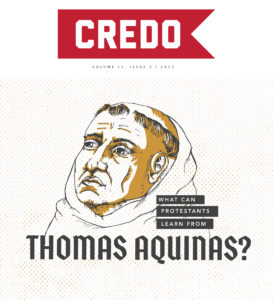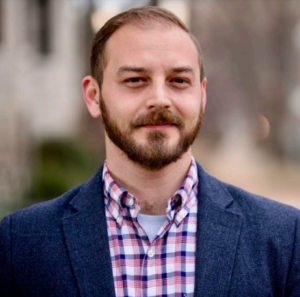
Beyond the Flesh: Why Aquinas is both a beacon and a bridge for orthodox Christology
The latest issue of C redo Magazine focuses on Thomas Aquinas. The following is one of the issue’s featured columns by K.J. Drake. Dr. Drake is Assistant Professor of Historical Theology and Academic Dean at Indianapolis Theological Seminary.
redo Magazine focuses on Thomas Aquinas. The following is one of the issue’s featured columns by K.J. Drake. Dr. Drake is Assistant Professor of Historical Theology and Academic Dean at Indianapolis Theological Seminary.
Thomas Aquinas begins Summa Theologicae Part III with reflections on the Incarnation of Christ as the means by which God wills to bring about the proper end of human existence by overcoming sin. This section of the Summa reinvigorated Chalcedonian Christology in the West.[1] Aquinas presents the Chalcedonian Decree [ST III.2.1.sc & III.2.2.sc], which was neglected by his contemporaries and predecessors like Peter Lombard, as the authoritative basis for orthodox Christology. Aquinas’s use of Chalcedon and the support of the Chalcedonian Christology of John of Damascus firmly established the unity of Christ’s divine and human natures without confusion or separation in the one eternal person of the Son. Aquinas’s emphasis on the hypostatic union did not diminish the distinctiveness of Christ’s two natures.
For instance, Aquinas repeatedly affirms that Christ remains omnipresent according to his divine nature even while taking to himself a finite and circumscribed human nature, what will come to be known as the extra Calvinisticum in later centuries. Christ’s presence extra carnem, beyond the flesh, in no way separates the person of Christ but rather secures his presence with the Church. Aquinas repeatedly affirms that Christ remains omnipresent according to his divine nature even while taking to himself a finite and circumscribed human nature. Share on X
Aquinas explains the extra carnem by reflecting on two descents, as noted by McGinnis, the “coming down” of the incarnation and his descent into hell on Holy Saturday.[2] To this, we must add Christ’s ascent into heaven. The idea that unites these events is the relation of the omnipresent Divine Son to his spatially defined human nature at points of cosmological transition.[3] The Son according to his divine nature remains omnipresent and transcendent of all space as he is one with the Father and the Holy Spirit, while the human nature of Christ and its parts, can come to be and move locally in created space. These moments of descent and ascent in the incarnate life of the Logos are explicated by Aquinas according to the mystery of the Incarnation as defined by Chalcedon. The eternal Son remains both true God, vere deus, and becomes true man, vere homo, by the assumption of the human nature into his preexistent personhood.
A key concept for understanding Aquinas’ Christology, and the extra carnem in particular, is that of a “mixed relation.”[4] Because of God’s aseity and immutability, he relates to creation without taking on any new properties, which reside only on the creaturely side of the relation. While all relations between the triune God and creation have this “mixed” or asymmetric quality, the Son’s assuming human nature into his own person is unique. Christ became everything that we are without ceasing to be everything he was in eternal communion with the Father and Spirit. As Thomas explains,
“To be man is newly predicated of God without any change in Him, by a change in the human nature, which is assumed to a Divine Person. And hence, when it is said, ‘God was made man,’ we understand no change on the part of God, but only on the part of the human nature.”[5]
This is true of all aspects of the Christ incarnation but particularly clarifies the relationship of the omnipresent divine nature and the particular spatially limited nature of the human body. When scripture says, God was made man, we understand no change on the part of God, but only on the part of the human nature. -Thomas Aquinas Share on X
The Incarnational Decent and Divine Omnipresence
Jesus repeatedly describes his relationship with the Father as having been “sent” (Mark 9:38; Luke 9:48; 10:16, John 5:23-24; 16:5 etc.) or “coming down” from heaven (John 3:13; 6:50-51, etc.). Do such statements mean that Christ moved according to his divine nature such that he was in a new place or ceased to be where he once was? Christ’s unity with the Father and the Spirit and the attributes of the divine nature utterly prohibits this. Aquinas explains such a sending according to the logic of mixed relation, “for since the divine persons are everywhere by essence, presence, and power, a [divine] person is said to be sent according to this, that he begins to be in a creature in a new mode through some new effect.”[6]
Therefore, the Son does not first become present in creation with the Incarnation, since as the eternal Logos he is always present. For Aquinas the “incarnational decent” must be understood as the assumption of the human nature by the divine person of the Son and not some coming-to-be or a change of location. Therefore, Christ in his new incarnate state is both localized in his human nature and body and everywhere as the eternal Word of the Father extra carnem. Thomas commenting on John 1:14 states,
He descended from heaven in such a way as yet to be in heaven. For he came down from heaven without ceasing to be above, yet assuming a nature which is from below. And because he is not enclosed or held fast by his body which exists on earth, he was, according to his divinity, in heaven and everywhere.[7]
While the human nature of Jesus Christ is in the closest possible relation with God, i.e. being hypostatically united to the Second Triune Person, yet he is not diminished or contained. The infinite remains beyond the bounds of the finite, even in that place were the infinite God reveals himself most fully in finite existence. “Not even in the union by personal being does the human nature comprehend the Word of God or the Divine Nature, for although it was wholly united to the human nature in the one Person of the Son, yet the whole power of the Godhead was not circumscribed by the human nature.” [8] Thomas ties this point into the Western tradition through appealing to Augustine.[9]
Christ’s divine nature does not shrink to the limits of bodily existence nor does his body fundamentally change. The body that Christ took to himself was a real human body like our own, local and circumscribed. Aquinas diligently demarcates the Creator/creature distinction in his articulation of Christ’s person and natures such that they remain unconfused and unchanged as Chalcedon confessed:
“So likewise the flesh is said to be deified…not by change, but by union with the Word, its natural properties still remaining, and hence it may be considered as deified, inasmuch as it becomes the flesh of the Word of God, but not that it becomes God.”[10]
The human nature assumed by the Word of God is ennobled, but the Word of God is not changed. -Thomas Aquinas Share on X Here Aquinas seeks to secure the integrity of both the human and divine natures in Christ, while acknowledging the closeness of their union. While Aquinas uses the language of deification it is qualified by a firm understanding of the distinct perfections of both God and man. The perfect human essence is not changed into divinity but united in differentiation with the Divine. “The human nature assumed by the Word of God is ennobled, but the Word of God is not changed.”[11]
Read the Full Article Here!
Endnotes
[1] Corey L. Barnes, “Thomas Aquinas’s Chalcedonian Christology and Its Influence on Later Scholastics,” The Thomist: A Speculative Quarterly Review 78, no. 2 (2014): 189–217; Jean-Pierre Torell, OP, “Saint Thomas and His Sources,” in The Oxford Handbook of the Reception of Aquinas, ed. Matthew Levering and Marcus Plested (Oxford; New York: Oxford University Press, 2021), 11–12.
[2] Andrew M. McGinnis, The Son of God Beyond the Flesh: A Historical and Theological Study of the Extra Calvinisticum, T & T Clark Studies in Systematic Theology 29 (London: Bloomsbury T&T Clark, 2014), 47.
[3] It should be noted that Thomas sees the circumscribed nature of the human body as part of its created nature and not as a defect created by the fall or that will be overcome in humanity’s glorification. For instance, the finitude of the body is not contained in Thomas’s discussion of the defect that Christ assumed from the body and overcame. ST III. Q.14. See also Thomas’s argument that God cannot make a body be in more than one place in Quodlibetal III.1.2.
[4] For the discussion of a “mixed relation” in connection with the Incarnation in Thomas see Michael Gorman, Aquinas on the Metaphysics of the Hypostatic Union (Cambridge, United Kingdom ; New York, NY: Cambridge University Press, 2017), 62–72; Dominic Legge, The Trinitarian Christology of St Thomas Aquinas, Reprint edition (Oxford, United Kingdom ; New York, NY: Oxford University Press, 2018), 19–21.
[5] ST III.6.6.ad.2.
[6] Contra errorres Graecorum I, c. 14. Quoted in Legge, The Trinitarian Christology of St Thomas Aquinas, 18.
[7] Thomas Aquinas, Commentary on the Gospel of John, Books 1-5, trans. Fabian R. Larcher and James A. Weisheipl, vol. 1 (Washington, D.C: The Catholic University of America Press, 2010), 177–78.
[8] ST III.10.1.ad.2.
[9] “Hence Augustine says (Ep. ad Volusian. cxxxvii): ‘I would have you know that it is not the Christian doctrine that God was united to flesh in such a manner as to quit or lose the care of the world’s government, neither did He narrow or reduce it when He transferred it to that little body.”” Quoted in ST III.10.1.ad.2.
[10] ST III.2.1.ad.3.
[11] ST III.2.6.ad.1.

